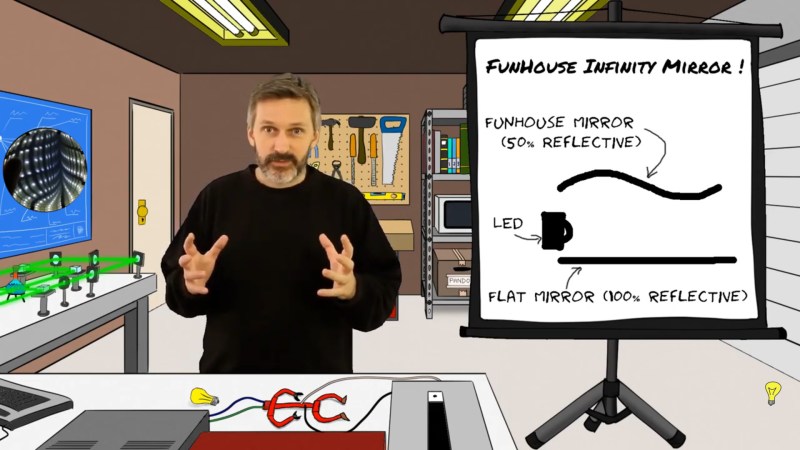Inventing often combines more than one old ideas into a new one. Even when the fused things are similar, the result can be more valuable than the sum of its parts. Unlike those analog watches with a digital clock below the face, when [Mojoptix] combined the re-reflecting properties of an infinity mirror with the image twisting qualities of a funhouse mirror, we get more than just a pair of mirrors. The resulting images look like a lot of fun. Warping one surface of two parallel mirrors doesn’t just alter the result a bit, because the planes feed off each other’s view, the final product is an exponentially skewed show.
Our host mounts a 3D printed ring with an hubward-facing strip of LEDs to an ordinary glass mirror. Over that, he designs four mated plates that hold semi-reflective film sheets in different shapes. The first is a hyperbolic paraboloid, but it’s probably easier to think of it as shaped like a Pringles chip (crisp). Once the light is applied, it looks like a bowtie made by a deranged god or the start of an infinite rabbit hole of light and reflection. To further the madness, he hits us with four shapes at once, so we hope you’ll take a moment to enjoy the video below.
This guy is no stranger to optics, and we’ve reported on a couple of other cool inventions that teach a concept through demonstration. His precision calipers demonstrate the Moiré effect, and his digital sundial capitalizes on parallel light beams.
As the legend goes, if you look into this thing at midnight, you’ll see your own death.















“The first is a hyperbolic paraboloid, but it’s probably easier to think of it as shaped like a Pringles chip (crisp).”
Nope, it’s a simple one direction curve, like a Lay’s Stax potato chip.
Try connecting the flexible mirror to a speaker and see what you get.
You need the speaker at the end of a short tube so nothing touches the mirror, let the pressure wave do the work.
Put the speaker tube up through the back of the rigid rear mirror and it will probably be almost unnoticeable.
If you seal the whole thing so it’s air tight, variations in barometric pressure will distort the film mirror and give you a different look from one hour to the next.
Would you need a large rigid cavity so there is more contained air than just what’s between the mirrors? I like it. Glance into the abyss, “Might want an umbrella.”
I wonder if anyone has tried using led displays instead of LEDs in an Infinity mirror.
I should imagine that could produce a few very interesting effects. Perhaps you could have your own Sliders portal.
A servo or low frequency analog driving a hard drive arm might animate things here quite well.
Wot wood happen if the sides were at a angle say 10 degrees
In the video 1:40 – 1:55 [Mojoptix] describes a beautiful process I experience but had mislabeled. He describes an inspiration, then tries to think of a test case with variables. He comes up with I dunno. Then he says a beautiful thing that you don’t hear in science class. “First I need to build up some intuition about how the shape…”. I had thought about my early ignorant experiments as failing, but iterating quickly. I think describing the process as building up intuition is a good way of describing the lurch from creative inspiration to variable bound improvement iteration.
In some ways I had been beating myself up in the early processes for not controlling variables. I think there is a good chance that my comfort with unrefined processes makes it so that I mostly work from intuition and then rarely nail down the variables, but end up close enough to my desired outcome that I don’t need to follow through to nail down the variations.
This is another great part of the inspiration process.